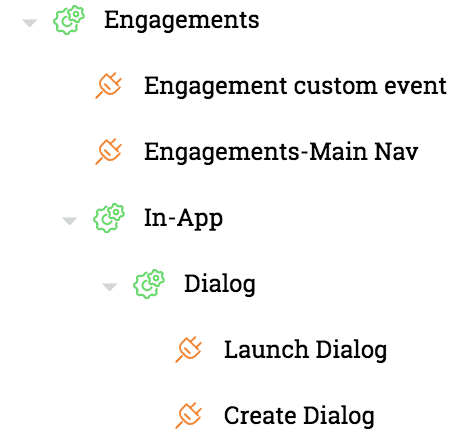Imagine a world where your computer didn’t have any folders, only files crowding your desktop.
That’s the feeling of analyzing usage of your product’s features without any hierarchy to organize them.

As the former CS Ops Director for a business intelligence software company, I invested a lot of time making the most of our usage analytics application, which was originally built for measuring general web traffic.
I’m proud of what I was able to create. With the help of their tool and their team, I increased usage, assisted our finance team with tracking down overdue invoices, won a customer award, and shared what I’d learned at their company events.
But if you’ve ever tried to use a pair of chopsticks to pick up those last few grains of rice, you know how much extra time is spent making a tool fit your needs—chopsticks are great, but not quite right for the task at hand. Let me share with you my Friday ritual.
Manual Tagging, Duplicates, Load Times, Oh My!
Every Friday around 4:00 p.m., I’d finish those last few important emails, grab a beer from the office kegerator, and spend the remainder of my day tagging pages in Pendo.
Since Pendo was originally built as a web analytics tool, I’d have to categorize every trackable element in our SaaS product as a “page.” These tags are a critical foundation for just about any analysis or in-app engagement. If you want to show something on one page, which you often do, or want to analyze one page, which you often do, you need that page to be set up and tagged.
The only way to make sense of it all is to manually tag everything on an ongoing basis. Hence, my Friday afternoon ritual. Every time a new product development rolled out or a user interacted with a new part of the product, new pages needed to be manually tagged so it could be recognized within Pendo. Without getting too technical, here is a step-by-step rundown of how I did that:
- Go to my list of untagged pages.
- Export the list of untagged pages—sometimes as big as 5,000 rows—into Excel to find those with the highest number of views.
- Dedupe the list against similar, but not quite identical, pages that had already been tagged.
- Find the top 5-10 most actively used, untagged pages.
- Go to each page within Pendo, one by one, and tag them.
- Wait 10 minutes or so while Pendo applied my new page to all historical data.
- Repeat steps 5-7 until you’ve tagged all the pages on your list.
- Leave work.
- Return on Monday and spend another half hour to verify that everything loaded as expected (usually, I was hit with at least one ‘gotcha’), adjust the page definitions to pull in similar pages (then wait for that historical process again), and assign them to categories.
Even after tagging was complete, it was hard to pinpoint the changes I’d just done or see how they fit into the rest of our pages. Because at the end of the day, the page I’d just tagged would still end up a part of a long list. Remember those 5,000 rows from earlier? Like that, but on a different tab. I would have to hunt for the right page or remember the exact name I’d given it so I could search for it. Troubleshooting was a burden.
One of the most daunting parts, though, couldn’t be helped by that beer I was sipping. It was knowing that I’d never finish. The most I could do was constantly chip away. I knew this was part of my life forever as an administrator because it’s so important for the product usage application to understand our product and map to it correctly. It was worthwhile doing, but I could’ve gotten further with fewer errors if the interface was better designed for this workflow.
Your success depends on a well-organized data

While having a beer at work on a Friday afternoon seems relaxing, I felt quite the opposite.
Being responsible for the organization of the application that reaches all of your users is a weighty burden. Good, clean data hygiene is very important. Without it, things can quickly get out of control and lead to significant challenges, especially when it comes to creating segments that accurately reflect user behaviors. Since these segments are the basis for filtering reports and triggering engagements, you end up with suspect reports and engagements that don’t always reach the right users.
Without having an intuitive feature hierarchy, there’s no way to use Pendo without configuring a giant list. Pages are not able to be nested within broader categories—they are files without folders. The one thing Pendo does give you is categories. So you can associate a set of pages to a certain category, but they don’t have any hierarchy. Think of it like a filter that can be applied to your list to make it a somewhat shorter list.
Having a well-organized feature hierarchy minimizes errors and allows you to scale without getting buried in untagged and untracked pages.
The feature hierarchy in Gainsight PX makes all the difference
Gainsight PX makes it easy to define a clean and well-organized hierarchy of features and modules without manual tagging. This saves you so much time and makes segment creation a snap. This intuitive tagging leaves no feature or module left behind, resulting in reports that can be trusted, and engagements that are precisely targeted.
Gainsight PX also offers many levels of nested hierarchy in the form of Modules, Submodules, and Features. In other words, folders Modules and Submodules represent a desktop folder, and your features represent files on your desktop. This organization makes it much easier to create and locate new additions to your product map.

Both Gainsight PX and Pendo track product activity. But, items that are not tagged in Pendo are dumped into an “untagged” list for review. Rather than display a ton of noise, Gainsight PX automatically places “untagged” elements in the appropriate place.
Take it from someone who’s been there
The weight of the business might be on your shoulders, but the choice to pick the right application for the job is up to you. A well-organized product map is a silent thing behind the curtain nobody knows about but cares about getting done well. So, anything making it better is a huge relief to an operations person that knows their business is relying on them to make sure their usage analytics platform is correctly interpreting the feature or pages in your app.
So let me leave you with one last question: would you rather drink a beer with your coworkers, or with a list of URLs? Take it from someone who’s been there and take a look at Gainsight PX.

